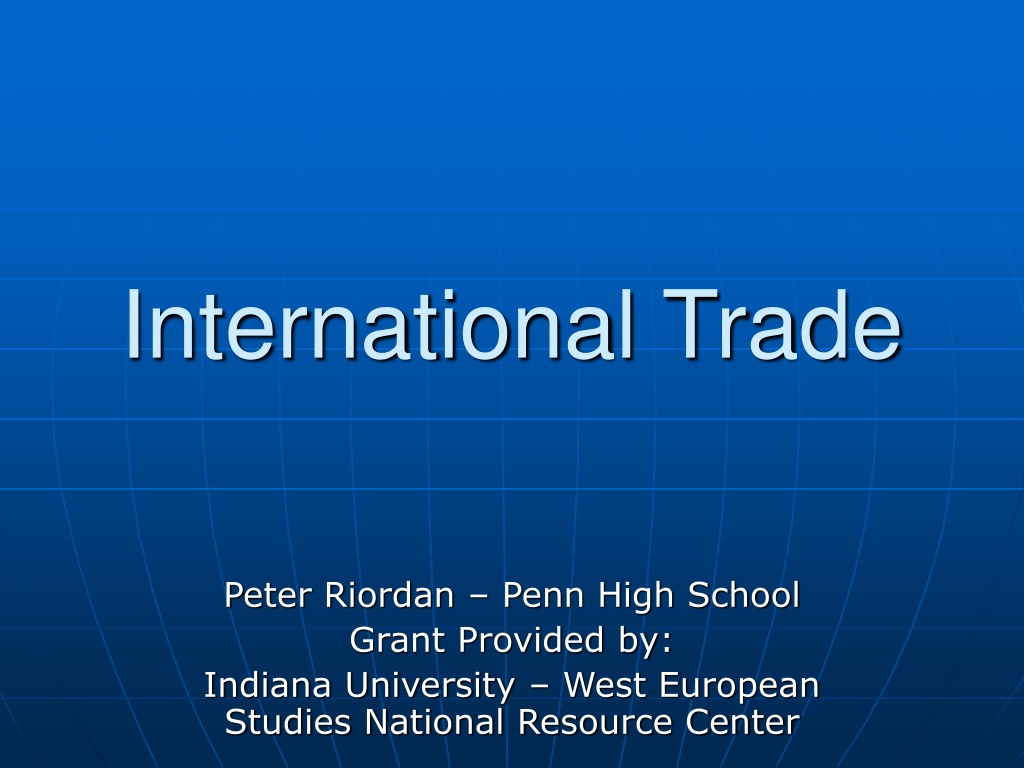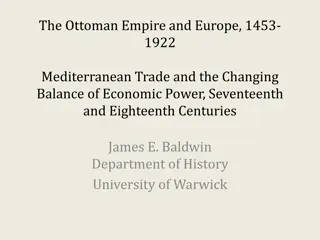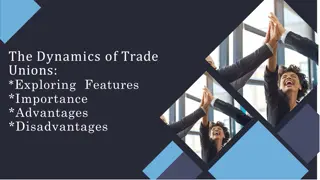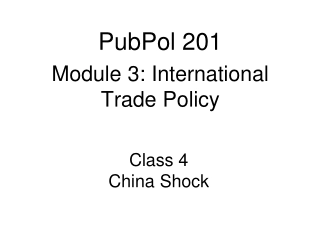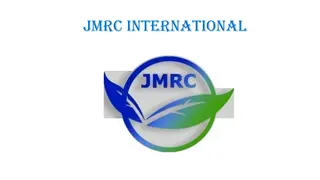Understanding International Trade: Importance, Basic Terms, and Specialization
International trade plays a crucial role in maintaining relations between countries and enabling them to access goods and services they may not have domestically. This article covers why countries trade, essential terms like imports and exports, and the concepts of specialization, absolute advantage, and comparative advantage in trade relationships.
Download Presentation
Please find below an Image/Link to download the presentation.
The content on the website is provided AS IS for your information and personal use only. It may not be sold, licensed, or shared on other websites without obtaining consent from the author. Download presentation by click this link. If you encounter any issues during the download, it is possible that the publisher has removed the file from their server.
Presentation Transcript
International Trade Peter Riordan Penn High School Grant Provided by: Indiana University West European Studies National Resource Center
Why Do Countries Trade With Each Other? Trade maintains and improves relations between countries. Trade allows countries to acquire goods and services, often natural resources or raw materials, that it does not have available to them. Trade allows countries to obtain products that other countries may produce more efficiently and therefore are less costly.
International Trade Some Basic Terms: Imports goods or services that a nation busy from other nations What type of goods does the U.S. import the most? A: crude oil, refined petroleum, automobiles, food and beverages, raw materials, and consumer goods Exports the goods or services that a nation produces and then sells to another nation What type of goods does the U.S. export the most? A: capital goods, industrial supplies, raw materials, agriculture products, and automobiles
International Trade Some Basic Terms: Specialization the idea of countries only making those products that they produce the most efficiently Absolute Advantage a country s ability to produce more of a given product than can another country Comparative Advantage a country s ability to produce a given product relatively more efficiently than another country or production at a lower opportunity cost
SPECIALIZATION The key to international trade is specialization. Even though one country may have an absolute advantage over another country in producing all concerned products it can still be beneficial for both countries to specialize and trade. Take some time to complete the Enrichment Activity and you will see for yourself.
Enrichment Activity Review Country A has the absolute advantage in producing DVD players because it can produce one in less time. Country A also has the absolute advantage in producing TV s because it takes less time than Country B. Product Country Country B A One DVD Player 3 hrs. 16 hrs. One TV 6 hrs. 8 hrs.
Enrichment Activity Review Even though Country A has the absolute advantage in producing both DVD players and TV s, it is still beneficial for both countries to specialize and trade if they consider comparative advantage. Country A has the comparative advantage in producing DVD players because it only gives up of a TV when it makes a DVD player compared to Country B who gives up 2 TV s when it makes 1 DVD player.
Enrichment Activity Review Country B, however, has the comparative advantage when producing TVs because it only gives up of a DVD player when it makes a TV compared to 2 DVD players that Country A gives up. Suppose the two countries only produce the products in which they have a comparative advantage and then decide to trade for the other product. Are the countries better off?
Enrichment Activity Review YES, both countries would benefit by specializing and trading. Both countries would now have one of each if they traded one TV for one DVD player. Both would save enough time to make one more of their respective product. Product Country A Country B DVD Players 6 hrs. (2x3hr) 0 hrs. TV s 0 hrs. 16 hrs. (2x8hr) Total Time 6 hrs. 16 hrs. Time Saved 9 - 6= 3 hrs. 24-16= 8 hrs.
Part II: How to Finance International Trade Different countries have different types of money. For example: United States Dollars, Japan Yen, Great Britain British Pound In Europe 12 countries use a single currency called the Euro. For the United States or any other country to be able to trade with another a country they must first obtain that country s currency to be able to pay for the products.
Part II: How to Finance International Trade Until 1971 a fixed exchange rate was used when converting one currency to another. This meant that every dollar, yen, or pound was worth a certain amount of gold. As trade and the supply of money grew there was no longer enough gold reserves to redeem foreign currencies, especially the U.S. Dollar. In 1971 the United States stopped redeeming foreign-held U.S. Dollars for gold. Since then a flexible exchange rate has been used.
Part II: How to Finance International Trade A flexible exchange rate relies on the forces of supply and demand to determine the value of one currency in relationship to another. This means the value of currencies fluctuates daily according to the availability and want for different currencies. The chart on the right is an example of a list of exchange rates for certain currencies at a money exchange located in the Shannon Airport in Ireland
Part II: How to Finance International Trade S As the supply of one currency grows then it loses value compared to another (top panel). As the demand of one currency grows then it increases in value compared to another (bottom panel). S2 D Q of $ S D2 D Q of $
Part II: How to Finance International Trade In 2002 twelve European Countries began using a single currency called the Euro. Those countries are: Austria, Belgium, Finland, France, Germany, Greece, Ireland, Italy, Luxembourg, the Netherlands, Portugal, and Spain. Because of increased demand for the Euro and increased supply of the U.S. Dollar, the Euro has increased in value compared to the U.S. Dollar. The Euro is currently stronger than the Dollar. What effect does this have on trade?
Part II: How to Finance International Trade First the bad news: It costs more for Americans to import European goods because it takes more Dollars to equal the Euro. It also costs more for Americans who are traveling in Europe to buy things How many American dollars would it cost to buy a one of these Value Meals in Dublin, Ireland?
Part II: How to Finance International Trade With an exchange rate of $1.22 to one Euro it would cost about $6.40 for the medium meal and about $6.90 for the large meal. How does this compare to what we pay here in the United States?
Part II: How to Finance International Trade Now some good news: As the Euro gains in strength compared to the Dollar then it becomes cheaper for the countries of the European Union to import American goods because they can buy more with a stronger currency. As this continues then there is an increase in the demand for Dollars which will eventually increase the value of the Dollar.
Part II: How to Finance International Trade Summary As the increase or decrease in the supply and demand of currencies changes so does the value of currencies in relationship to one another. Because the effect of these changes in greatly influence a country s economy it is important the you understand the causes and effects of a flexible exchange rate.
